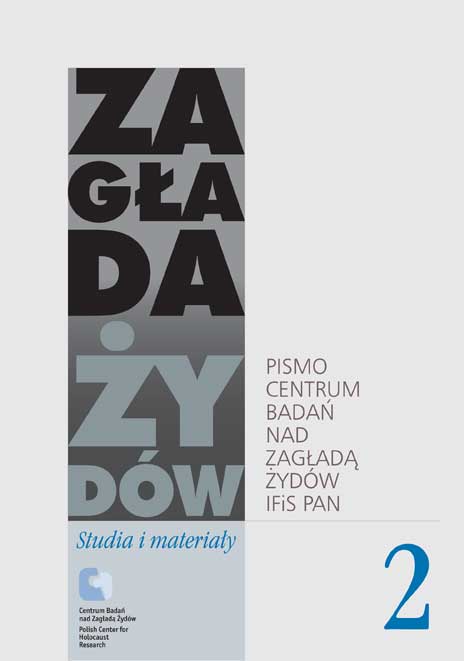Nazistowski mord na Żydach w prasie polskich komunistów (1942–1944).
Zagłada Żydów. Studia i Materiały, Nr 2 (2006), Strony: 54-75
Data zgłoszenia: 2020-10-11Data publikacji: 2006-12-02
 https://doi.org/10.32927/ZZSiM.180
https://doi.org/10.32927/ZZSiM.180
Abstrakt
Facing the decisive struggle between Nazism and Soviet communism for dominance in Europe, in 1942/43 Polish communists sojourning in the USSR espoused anti-German concepts of the political right. Their aim was an ethnic Polish ‘national communism’. Meanwhile, the Polish Workers’ Party in the occupied country advocated a maximum intensification of civilian resistance and partisan struggle. In this context, commentaries on the Nazi judeocide were an important element in their endeavors to influence the prevailing mood in the country: The underground communist press often pointed to the fate of the murdered Jews as a warning in order to make it clear to the Polish population where a deficient lack of resistance could lead. However, an agreed, unconditional Polish and Jewish armed resistance did not come about.
At the same time, the communist press constantly expanded its demagogic confrontation with Polish “reactionaries” and accused them of shared responsibility for the Nazi murder of the Jews, while the Polish government (in London) was attacked for its failure. This antagonism was intensified in the fierce dispute between the Polish and Soviet governments after the rift which followed revelations about the Katyn massacre. Now the communist propaganda image of the enemy came to the fore in respect to the government and its representatives in occupied Poland. It viewed the government-in-exile as being allied with the “reactionaries,” indifferent to the murder of the Jews, and thus acting ultimately on behalf of Nazi German policy. The communists denounced the real and supposed antisemitism of their adversaries more and more bluntly. In view of their political isolation, they coupled them together, in an undifferentiated manner, extending from the right-wing radical ONR to the social democrats and the other parties represented in the underground parliament loyal to the London based Polish government. Thereby communist propaganda tried to discredit their opponents and to justify the need for a new start in a post-war Poland whose fate should be shaped by the revolutionary left. They were thus paving the way for the ultimate communist takeover
Słowa kluczowe
Zagłada , Sowieci a Zagłada , prasa komunistyczna , Katyń , antysemityzm
Licencja
Prawa autorskie (c) 2006 Autor & "Zagłada Żydów. Studia i Materiały"

Utwór dostępny jest na licencji Creative Commons Uznanie autorstwa 4.0 Międzynarodowe.
https://creativecommons.org/licenses/by/4.0
Inne teksty tego samego autora
- Klaus Peter Friedrich, Isaiah Trunk, Łódź Ghetto: A History; Andrea Löw, Juden im Getto Litzmannstadt. Lebensbedingungen, Selbstwahrnehmung, Verhalten , Zagłada Żydów. Studia i Materiały: Nr 3 (2007)
Podobne artykuły
- Agnieszka Haska, Międzynarodowa konferencja naukowa „Być świadkiem Zagłady”(Warszawa, 22–23 kwietnia 2013 r.) , Zagłada Żydów. Studia i Materiały: Nr 9 (2013)
- Redakcja Czasopisma, Nagroda im. Israela Gutmana dla Karoliny Panz , Zagłada Żydów. Studia i Materiały: Nr 12 (2016)
- Alina Skibinska, „Ludzie opowiadali rzeczy potworne o tym, co się tam działo”. Dwa świadectwa Zagłady – Adama Ulricha z Zakrzówka i Stanisława Ż(Rz)emińskiego z Łukowa , Zagłada Żydów. Studia i Materiały: Nr 13 (2017)
- Grzegorz Krzywiec, A Polish Weininger? The Case of Julian Unszlicht (1883–1953) , Zagłada Żydów. Studia i Materiały: 2010: Holocaust Studies and Materials
- Redakcja, Od Redakcji , Zagłada Żydów. Studia i Materiały: Nr 17 (2021)
- Jan Tomasz Gross, Czy Zagłada jest ich historią, czy naszą? (Plaidoyer w przedmiocie ustanowienia w Polsce miejsca pamięci poświęconego Zagładzie) , Zagłada Żydów. Studia i Materiały: Nr 13 (2017)
- Grzegorz Krzywiec, Nadwiślański Weininger? Przypadki Juliana Unszlichta (1883–1953) , Zagłada Żydów. Studia i Materiały: Nr 5 (2009)
- Piotr Kendziorek, Martyna Jonas-Kowalik, Jutro wolni? Komuniści w ruchu oporu w getcie warszawskim , Zagłada Żydów. Studia i Materiały: Nr 19 (2023)
- Andrzej Czyżewski, Pamięć marginalizowana, niechciana, cicha… – łódzkie getto w polityce pamięci historycznej PRL , Zagłada Żydów. Studia i Materiały: Nr 16 (2020)
- Alina Skibinska, Dariusz Libionka, „Przysięgam walczyć o wolną i potężną Polskę, wykonywać rozkazy przełożonych, tak mi dopomóż Bóg”. Żydzi w AK. Epizod z Ostrowca Świętokrzyskiego , Zagłada Żydów. Studia i Materiały: Nr 4 (2008)
<< < 1 2 3 4 5 6 7 8 9 10 11 12 13 14 15 16 17 18 19 20 21 22 23 24 25 26 27 28 29 30 31 32 33 > >>
Możesz również Rozpocznij zaawansowane wyszukiwanie podobieństw dla tego artykułu.
 English
English
 Język Polski
Język Polski








